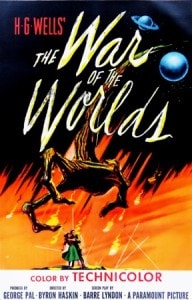“If they’re mortal, they must have mortal weaknesses. They’ll be stopped, somehow.”——Gene Barry
The original version of The War of the Worlds was a product of the horror/science fiction films of the 1950s following World War II and expressing latent fears of the hydrogen bomb and Russian invasions. Although the genre has never gone out of style since, the ’50s inspired perhaps the greatest period of voyages to other planets, monsters from outer space, mutant insects and robots gone amuck. Not many masterpieces among the lot, but the films were often quirky, sometimes original and frequently absorbing. When not comically amateurish, the special effects were occasionally ground-breaking, startling in their day, though crude by today’s computer-generated standards.
Even the Japanese got in on Hollywood’s act—“monster” men in rubber suits in such “epics” as Godzilla and Rodan, which often provided more laughs than anything else. The British, a decade later, followed with the more sophisticated The Day the Earth Caught Fire and First Men In the Moon, an intelligent version, comic elements aside, of the H. G. Wells novel, with Ray Harryhausen stop-action Moon Men and a giant caterpillar.
The 1953 movie version of Wells’ 1898 novel The War of the Worlds stars Gene Barry, Ann Robinson and Les Tremayne, with small parts—sometimes only a single line, if that—for Jack Kruschen, Henry Brandon, Robert Cornthwaite and Vernon Rich. Some famous people have non-speaking appearances: actress Carolyn Jones and Fred Zendar, diving master and technical adviser on a number of “watery” films. Even the film’s producer George Pal is seen as a bum listening to a radio. Pal is responsible for a few other similar films—When Worlds Collide, Destination Moon, Atlantic, Conquest of Space and The Time Machine, based on another Wells novel.
The War of the Worlds is tightly directed by Byron Haskin, who also has to his credit such companion horror/science fiction flicks as The Naked Jungle, Conquest of Space, From the Earth to the Moon and Robinson Crusoe on Mars. He often collaborated with Pal.
